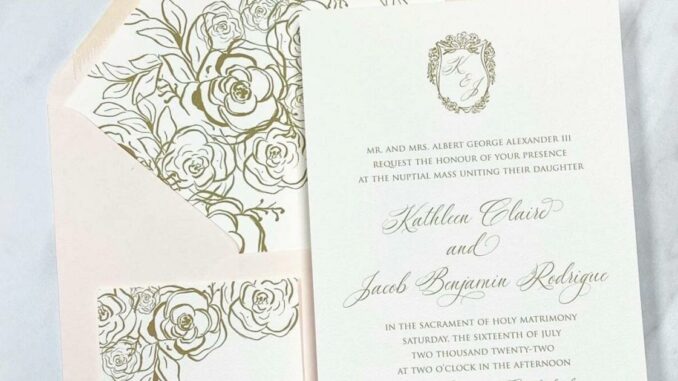
Designing, packaging and sending out wedding invitations can seem like a steep undertaking. From the engagement party to the save the dates to the actual wedding, invitations allow guests to prepare for what’s to come.
“An invitation is like a preview to your wedding,” says Lauren Brasseaux of Sibley Designs in Lafayette. “It sets the tone for what kind of wedding you’re going to have.”
When Brasseaux meets with a bride for the first time, she starts with the basics. Where is the wedding? How many people are invited? What kind of flowers will there be? Does the couple define their style as classic, bohemian, modern or something else?
“You may not notice the carving station, cake topper, mints or matches, but everyone is going to have the invitation in their hand — and it’s going to be the thing that sets the tone for the wedding,” Beauboeuf said. “We’re honored that people trust us.” This invitation is from The Queen Bee.
Timelines
So, the ring is secured. The wedding planner is locked down. The date is picked. When should a visit to the stationery store be checked off the list? Brasseaux says she and her team rely on The Emily Post Institute to help brides with timelines and appropriate wording for invitations. She recommends brides send a save-the-date card six to eight months in advance, while the wedding invitation should be sent out six to eight weeks in advance.
However, after the pandemic, Brasseaux said that she’s now seeing brides send out invitations earlier — two months in advance for wedding invitations and anywhere from six months to a year for save the dates.
Michelle Beauboeuf, with The Queen Bee in Baton Rouge, said that she tells her clients not to send out save-the-date notices if someone is within six months of the wedding. However, if a ceremony is a destination wedding or around the holidays, the earlier the better.
“Etiquette is just a guideline,” said Kathryn Podorsky, with Paperwhite Stationery Boutique in Baton Rouge. “It’s not the Bible. It helps eliminate hurt feelings and awkwardness sometimes.”

“An invitation is like a preview to your wedding,” says Lauren Brasseaux of Sibley Designs. “It sets the tone for what kind of wedding you’re going to have.” This invitation is from Sibley Designs.
Proper etiquette
The rules for wedding etiquette can seem never-ending and quite specific. Nevertheless, basic invitation rules still apply. One should include who is hosting, the nature of the event, where and when it will take place, and how a guest should respond.
Beauboeuf’s tips for the progression of wording:
- If someone is getting married at a place of worship, the invitation will typically read, “request the honor of your presence.”
- On the other hand, for a ceremony elsewhere, the invitation will read, “request the pleasure of your company.”
- After the introduction of the bride and groom, the time, date and place should follow (in that order).
- To indicate that children are not allowed at the reception, the invitation should include, “adult reception to follow” at the bottom. More often than not, Beauboeuf said she will put the reception location on the wedding invitation.
- Any registry invitation should not be included on a wedding invitation. Instead, one can put it on a bridal shower invitation.
When it comes to arranging RSVPs, Brasseaux said that more couples are opting to include a details card that asks guests to reply on a wedding website. However, she said the ratio of reply cards to wedding websites is “half and half” right now.
“A lot of people say that 60% of your guest list will show up anyway,” Brasseaux said.

Couples can choose to have invitations calligraphed completely or choose to calligraph the bride and groom’s names and the location. This invitation is from Paperwhite Stationery Boutique.
Trends versus traditions
While many people take a modern approach to invitations, there are some design concepts that stand the test of time. Though, there is no right or wrong way to design a wedding invitation since it’s based on personal preference.
One of the trends that Brasseaux has seen in recent years is crests that include various personal elements like specific flowers, paintings of dogs and certain hometown mementos.
“(Crests) can symbolize the couple really nicely, and you can apply it to stationery that you could use for years to come,” Brasseaux said.
Beauboeuf said that clients still order thick cards with a gold-foil edge and engraving.
“No matter how much invitations have changed over the years, our brides will still usually take every opportunity to honor the traditions — and they take any chance to input a design element,” Beauboeuf said.
For example, she says custom monograms are having a moment right now, which can be transferred to cups, napkins, ceremony programs, return addresses, cup koozies and more.
To Beauboeuf, though, lettering and fonts are the art. Couples can choose to have invitations calligraphed completely or choose to calligraph the couple’s individual names and the location.
“The bigger the names the better,” she said. “Nothing is prettier than letting the text speak for itself.”
Podorsky said that double inner and outer envelopes are also a tradition, particularly in the South.
“We still do a lot of the double envelopes, and that’s not a thing in upper East Coast states,” Podorsky said.
She also said that some brides try to coordinate everything from the save-the-date card to the invitation to the thank you notes, which helps the invitation suite to look more cohesive.

Custom monogram designs can be transferred to cups, napkins, ceremony programs, return addresses cup koozies and more. This invitation is from Paperwhite Stationery Boutique.
Envelope addressing
Podorsky has a few pointers to avoid some of the common mistakes she sees when addressing wedding envelopes.
1. Sending out a save-the-date card helps to notify your guests and gives you the chance to test your address list.
2. Start gathering the information early. Some wedding websites can send out automatic texts to your guests asking them to fill out their names and addresses.
3. Proofread your list before sending it to a stationery store. Have someone else proofread it too.
4. Avoid abbreviations in addresses. Spell everything out — 102 Oak Drive, 304 Pine Street, 722 Marion Boulevard, 516 Bailey Avenue, etc.
5. On the outer envelope, if two people live together, but are not married, the woman’s name should always go on the top line — the same rule applies if you’re inviting two single people who live in the same house. One should only use “and” if two people are married, and in that case, the woman’s name should also go first.
Details: Traditionally for married couples, you include the male’s first and last name (Mr. and Mrs. John Doe) —a rule that only applies for married couples with the same last name and even with that has caveats. If you are bothered that the woman’s name is not included, an alternative is: Jane and John Doe. If the couple has different last names: Jane Rushing and John Doe.
6. Inner envelopes include who is invited within the household. If children are invited, their names are listed by first name and separated with a comma.

Leave a Reply